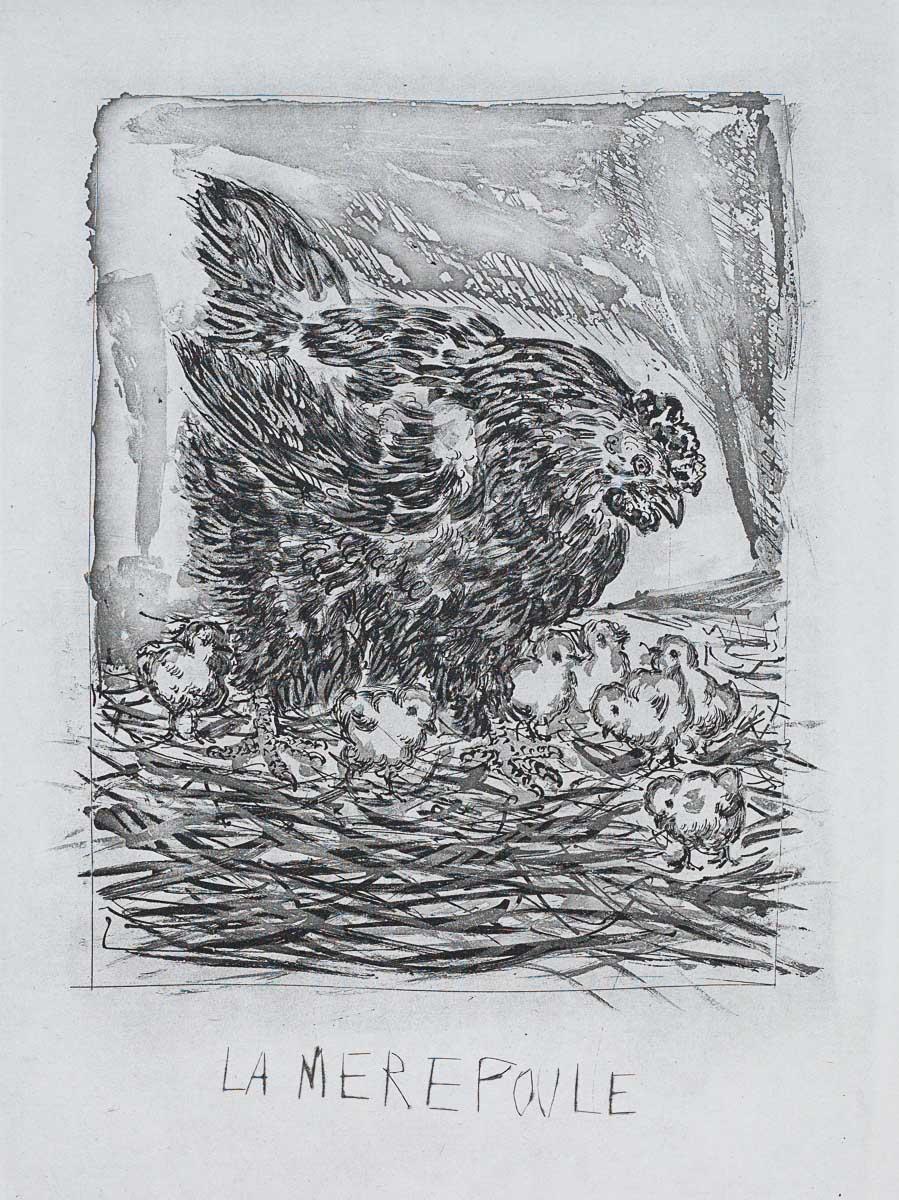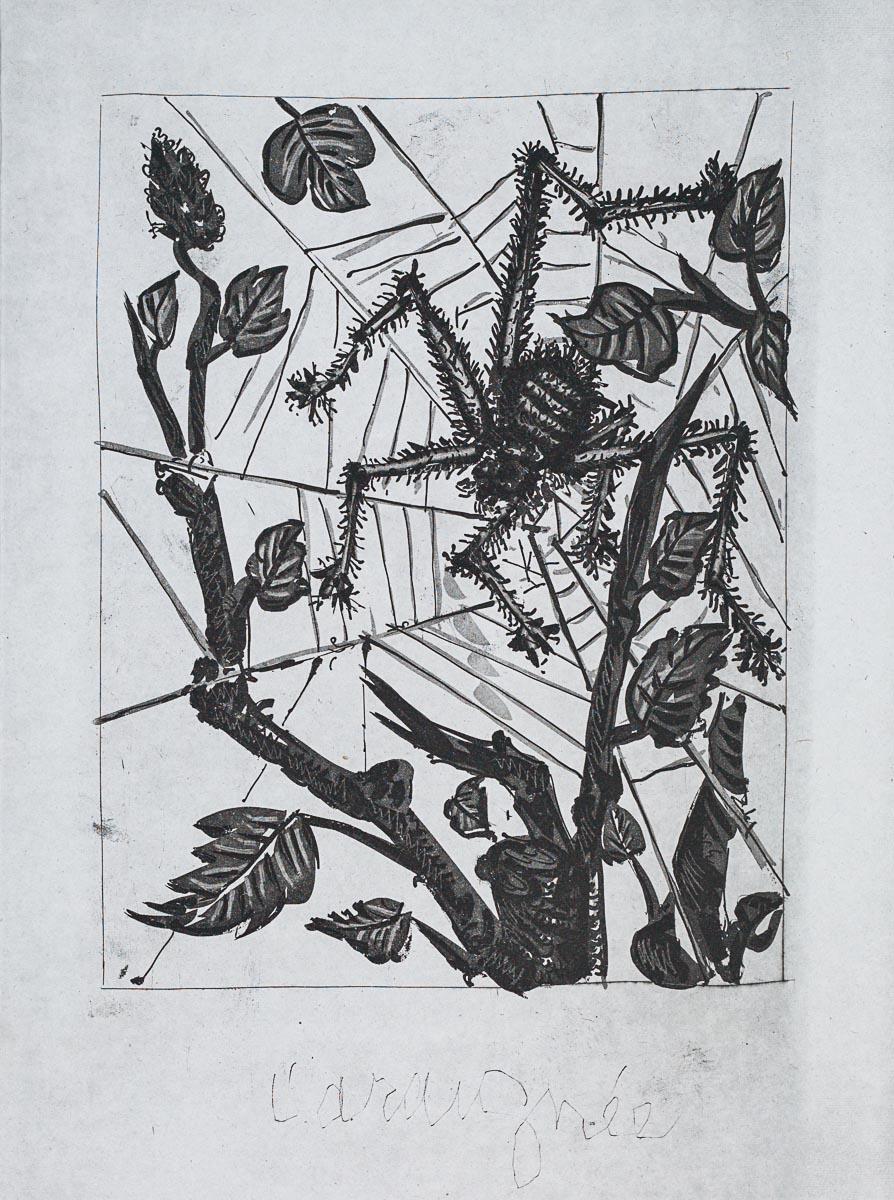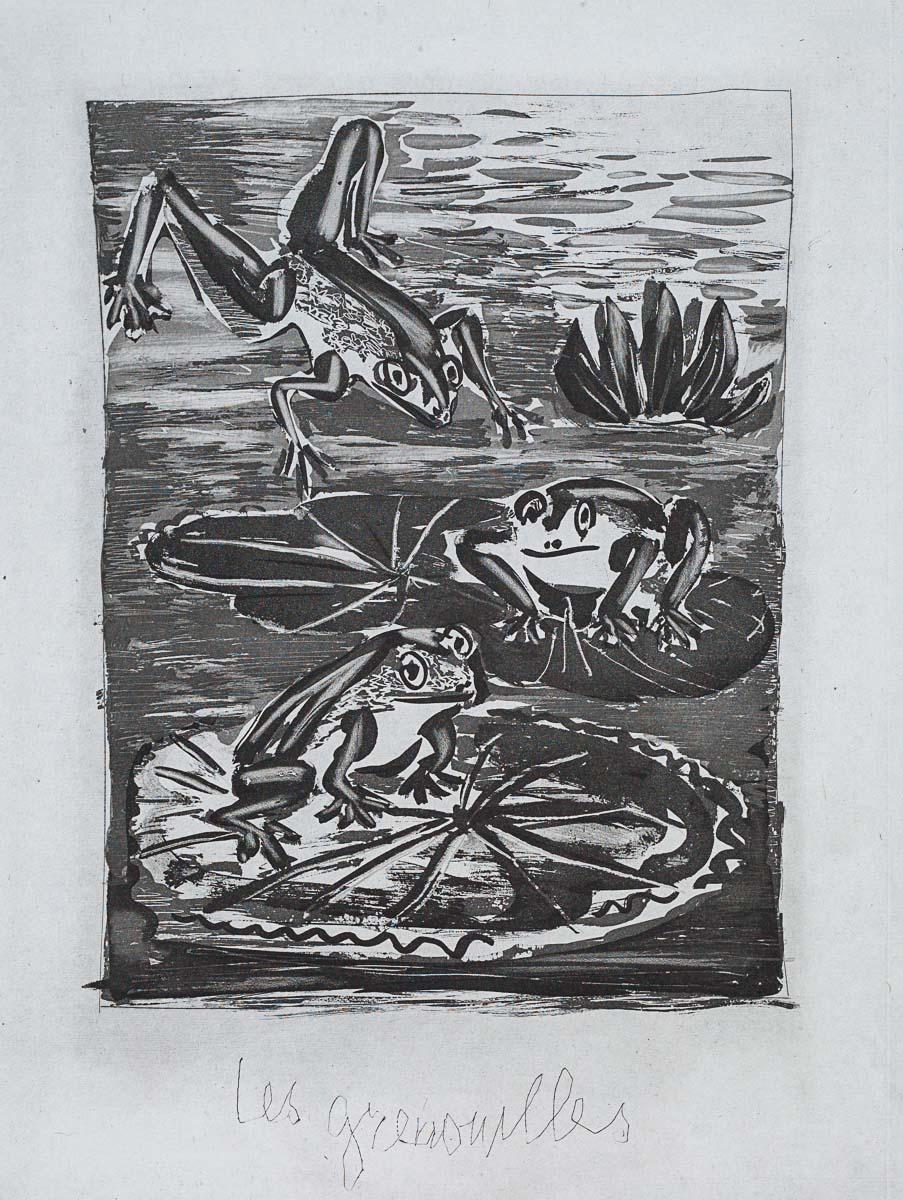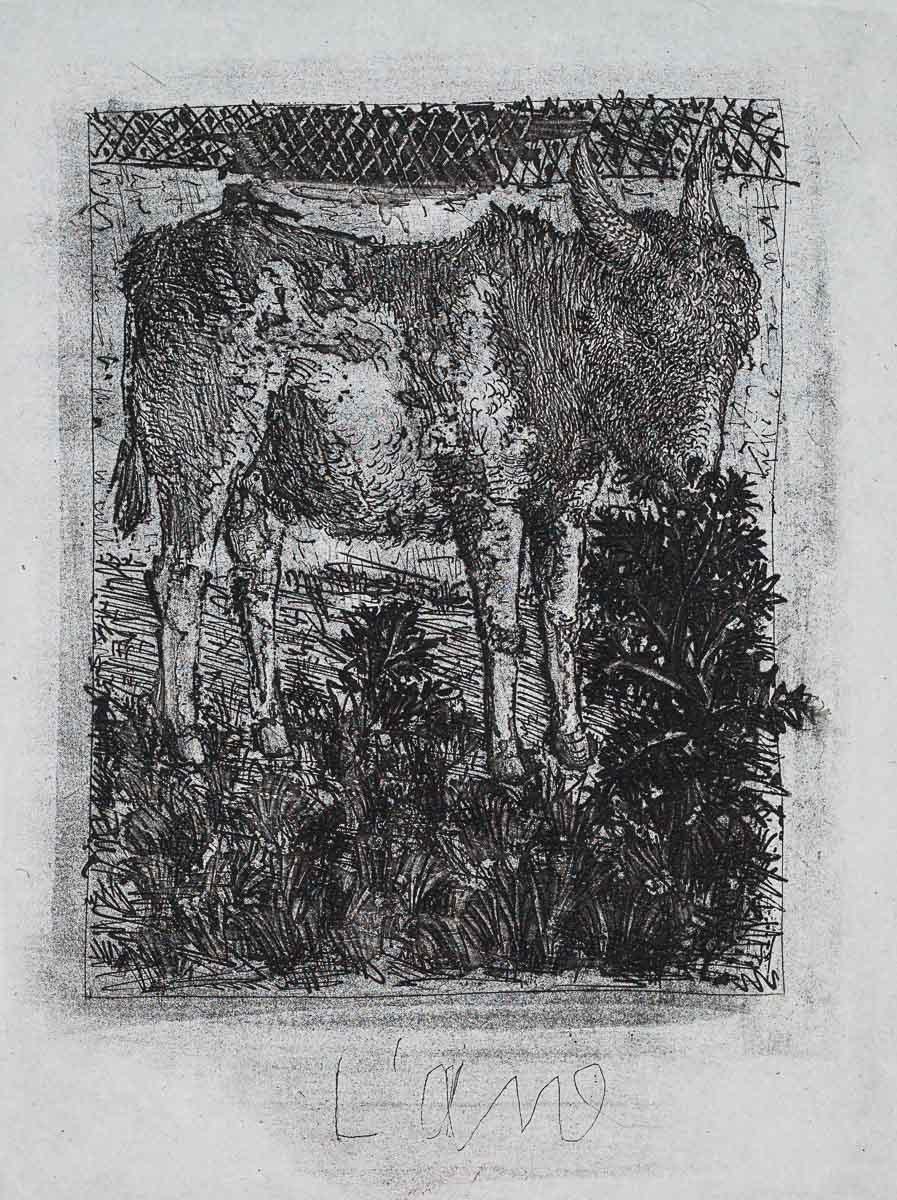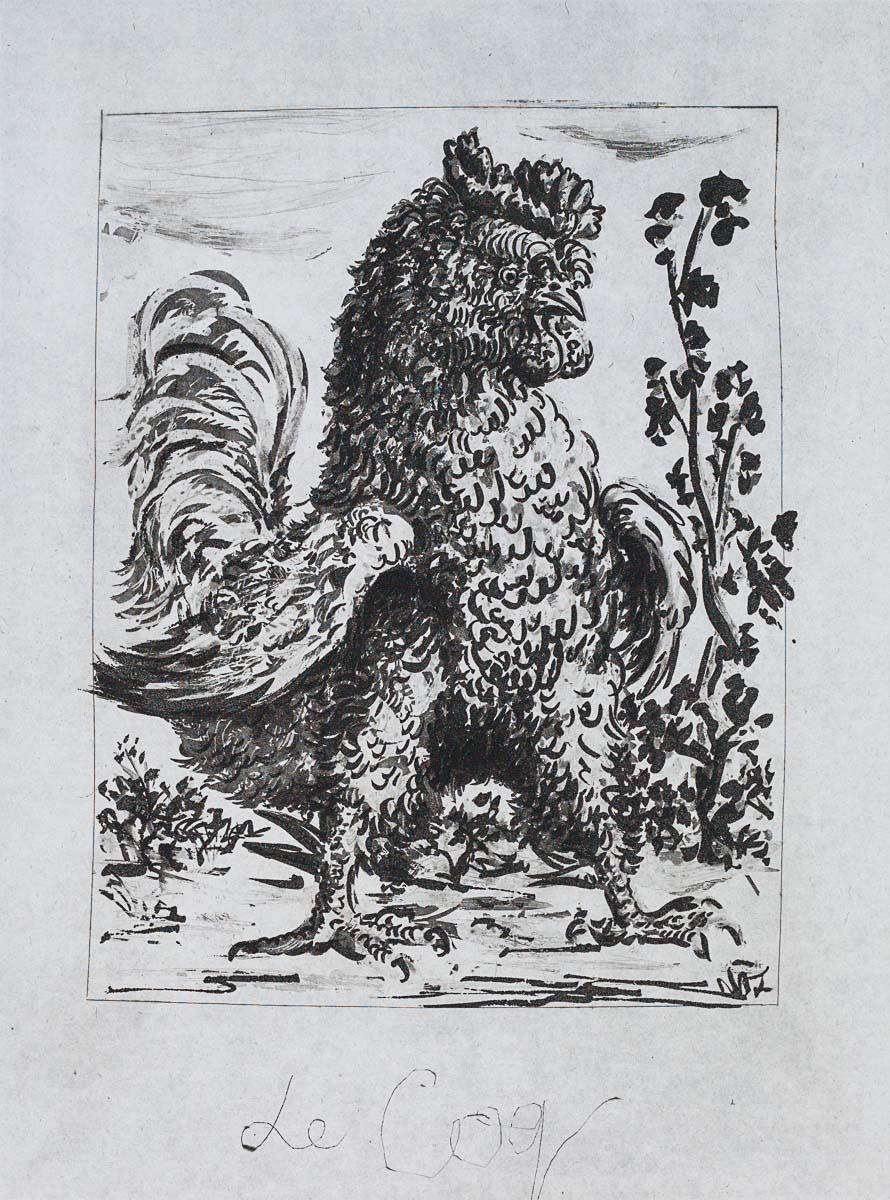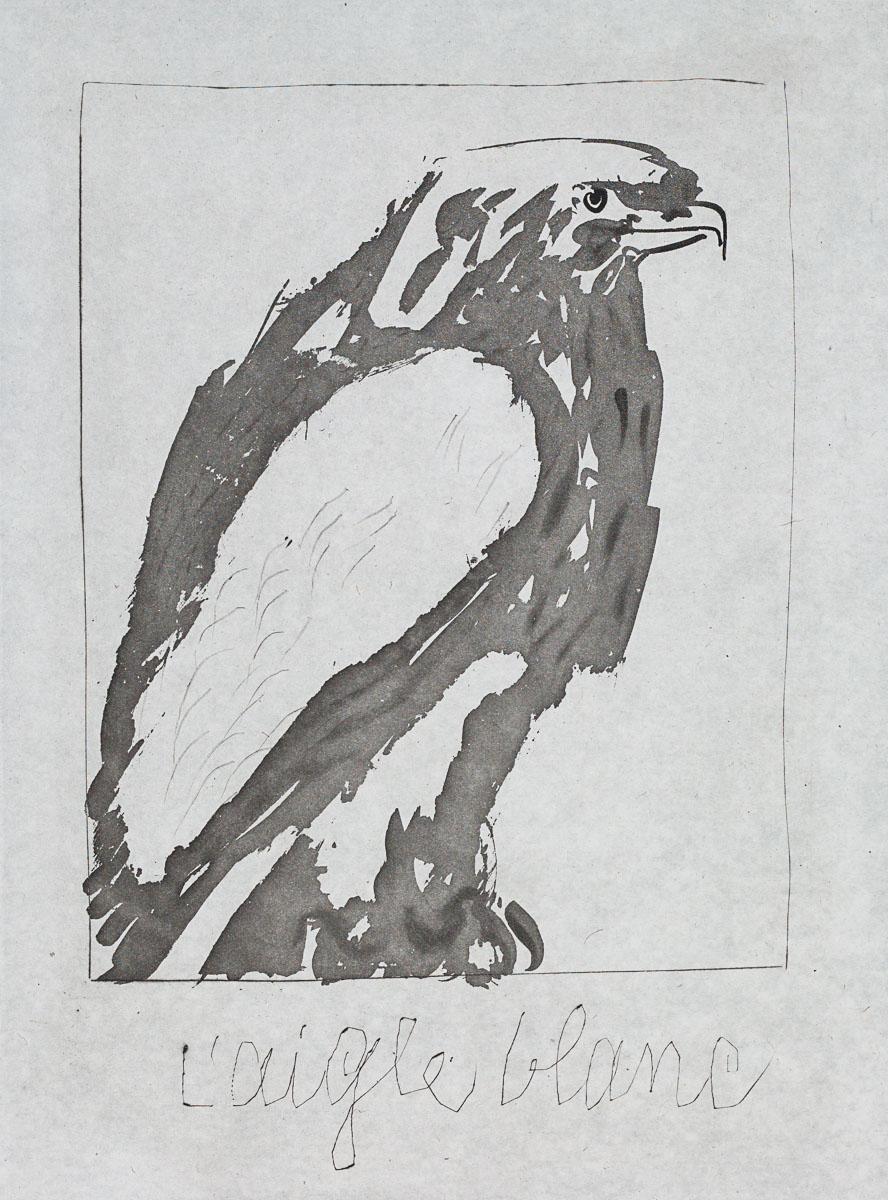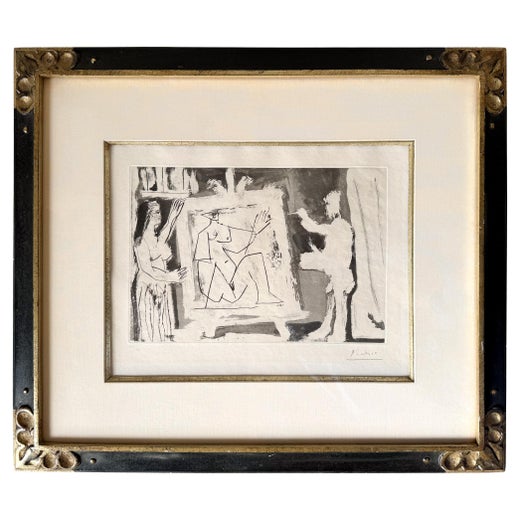Pablo PicassoThe Goldfinch, 1942 (Histoire Naturelle - Textes de Buffon, B.348 )1942
1942
About the Item
- Creator:Pablo Picasso (1881-1973, Spanish)
- Creation Year:1942
- Dimensions:Height: 24.125 in (61.28 cm)Width: 20.5 in (52.07 cm)
- Medium:
- Movement & Style:
- Period:
- Condition:generally excellent condition with some minor creases and handling dents.
- Gallery Location:Greenwich, CT
- Reference Number:
Pablo Picasso
One of the most prolific and revolutionary artists the world has ever seen, Pablo Picasso had a tremendous impact on the development of 20th-century modern art. Although he is best known for his association with the Cubist movement, which he founded with Georges Braque, Picasso’s influence extends to Surrealism, neoclassicism and Expressionism.
“Every act of creation is, first of all, an act of destruction,” the Spanish artist proclaimed. In Picasso's Cubist paintings, he emphasizes the two-dimensionality of the canvas, breaking with conventions regarding perspective, foreshortening and proportion. Picasso was inspired by Iberian and African tribal art. One of his most famous pre-Cubist works is Les Demoiselles d’Avignon (1907), a painting considered immoral and shocking at the time for its depiction of nude women whose faces resemble Iberian tribal masks.
Picasso made many portraits in this style, most often of the women in his life, their expressively colored faces composed of geometric shards of surface planes. In Woman in a Hat (Olga), 1935, he painted his first wife as an assemblage of abstract forms, leaving the viewer to decipher the subject through the contrasting colors and shapes. Picasso was a tireless artist, creating more than 20,000 paintings, drawings, prints, ceramics and sculptures. Tracing his life’s work reveals the progression of modern art, on which he had an unparalleled influence.
Browse an expansive collection of Pablo Picasso's art on 1stDibs.
- ShippingRetrieving quote...Ships From: San Fernando, CA
- Return PolicyA return for this item may be initiated within 3 days of delivery.
- The Mother Hen, 1942 (Histoire Naturelle - Textes de Buffon, B.345)By Pablo PicassoLocated in Greenwich, CTThe Mother Hen is an aquatint and drypoint print on chine from one of the deluxe copies of Picasso's 1942 Histoire Naturelle - Textes de Buffon series. The image size is 10.6 x 8 inc...Category
20th Century Modern Prints and Multiples
MaterialsDrypoint, Aquatint
- The Spider, 1942 (Histoire Naturelle - Textes de Buffon, B.353)By Pablo PicassoLocated in Greenwich, CTThe Spider is an aquatint and drypoint print on chine from one of the deluxe copies of Picasso's 1942 Histoire Naturelle - Textes de Buffon series. The image size is 10.5 x 8 inches, unsigned as issued, and framed in a contemporary silver and gray moulding. One of about 36 prints that exist with Picasso's remarqued title in French, from the edition of 262 (there were 226 portfolios, some with additional sets on varying papers). Catalogue - Cramer #37 The exceptional etchings from Picasso’s Histoire Naturelle – Textes de Buffon are a masterful combination of sugar-lift aquatint and drypoint, showcasing a full range of gray tonalities. The etchings of animals, birds and insects are considered some of the most beautiful and most unusual examples of Picasso’s graphic work. Roger Lacourière, Picasso’s master printer, pulled the prints for each etching between 1939-1942. It was Lacourière who taught Picasso the sugar-lift aquatint technique which allowed him to mimic the effect of brushstrokes in these etched images. Picasso first explored the technique in his plates for the Vollard Suite, but it was in the creation of the Buffon images that he fully realized its stunning, painterly potential. For the edition, 226 portfolios were produced with the first thirty-six counting as deluxe compilations. These rare deluxe sets were on diverse papers (chine, japon or vergé ancien) and each included a complete additional suite showing Picasso’s title remarques along the bottom. As such, the remarqued versions of the prints are quite rare with just thirty-six of each produced for the edition (with the exception of The Wolf which is never remarqued – the image always fills the entire etching plate). These prints are based on the writings of French naturalist Georges-Louis Leclerc, Comte de Buffon, who extensively documented the natural world in his monumental work Histoire Naturelle. Picasso’s association with the project to illustrate parts of the Buffon came during a tumultuous time in European history – the prelude to, and early years of, World War II. As the continent was ravaged, Picasso lived through the disaster in Paris, which the Germans occupied in 1940. These prints could be seen as a political statement – Picasso channeling his artistic expression into a form of resistance art...Category
20th Century Modern Prints and Multiples
MaterialsDrypoint, Aquatint
- The Frog, 1942 (Histoire Naturelle - Textes de Buffon, B.357)By Pablo PicassoLocated in Greenwich, CTThe Frog is an aquatint and drypoint print on chine from one of the deluxe copies of Picasso's 1942 Histoire Naturelle - Textes de Buffon series. The image size is 10.6 x 7.9 inches,...Category
20th Century Modern Prints and Multiples
MaterialsDrypoint, Aquatint
- The Donkey, 1942 (Histoire Naturelle - Textes de Buffon, B.329)By Pablo PicassoLocated in Greenwich, CTThe Donkey is an aquatint and drypoint print on chine from one of the deluxe copies of Picasso's 1942 Histoire Naturelle - Textes de Buffon series. The image size is 10.5 x 8 inches,...Category
20th Century Modern Prints and Multiples
MaterialsDrypoint, Aquatint
- The Rooster, 1942 (Histoire Naturelle - Textes de Buffon, B.344)By Pablo PicassoLocated in Greenwich, CTThe Rooster is an aquatint and drypoint print on chine from one of the deluxe copies of Picasso's 1942 Histoire Naturelle - Textes de Buffon series. The image size is 10.6 x 8.15 inc...Category
20th Century Modern Prints and Multiples
MaterialsDrypoint, Aquatint
- The White Eagle, 1942 (Histoire Naturelle - Textes de Buffon, B.340)By Pablo PicassoLocated in Greenwich, CTThe White Eagle is an aquatint and drypoint print on chine from one of the deluxe copies of Picasso's 1942 Histoire Naturelle - Textes de Buffon series. The image size is 10.5 x 8.15 inches, unsigned as issued, and framed in a contemporary silver and gray moulding. One of about 36 prints that exist with Picasso's remarqued title in French, from the edition of 262 (there were 226 portfolios, some with additional sets on varying papers). Catalogue - Cramer #37 The exceptional etchings from Picasso’s Histoire Naturelle – Textes de Buffon are a masterful combination of sugar-lift aquatint and drypoint, showcasing a full range of gray tonalities. The etchings of animals, birds and insects are considered some of the most beautiful and most unusual examples of Picasso’s graphic work. Roger Lacourière, Picasso’s master printer, pulled the prints for each etching between 1939-1942. It was Lacourière who taught Picasso the sugar-lift aquatint technique which allowed him to mimic the effect of brushstrokes in these etched images. Picasso first explored the technique in his plates for the Vollard Suite, but it was in the creation of the Buffon images that he fully realized its stunning, painterly potential. For the edition, 226 portfolios were produced with the first thirty-six counting as deluxe compilations. These rare deluxe sets were on diverse papers (chine, japon or vergé ancien) and each included a complete additional suite showing Picasso’s title remarques along the bottom. As such, the remarqued versions of the prints are quite rare with just thirty-six of each produced for the edition (with the exception of The Wolf which is never remarqued – the image always fills the entire etching plate). These prints are based on the writings of French naturalist Georges-Louis Leclerc, Comte de Buffon, who extensively documented the natural world in his monumental work Histoire Naturelle. Picasso’s association with the project to illustrate parts of the Buffon came during a tumultuous time in European history – the prelude to, and early years of, World War II. As the continent was ravaged, Picasso lived through the disaster in Paris, which the Germans occupied in 1940. These prints could be seen as a political statement – Picasso channeling his artistic expression into a form of resistance art...Category
20th Century Modern Prints and Multiples
MaterialsDrypoint, Aquatint
- Le SingeBy Pablo PicassoLocated in New York, NYA very good impression of this aquatint, grattoir and drypoint. Edition of 225. Printed by Lacourière, Paris. Published by Martin Fabiani, Paris. From "Histoire Naturelle." Catalogu...Category
1930s Modern Abstract Prints
MaterialsDrypoint, Aquatint, Etching
- Salvador Dali - The Rider and the Deer - Handsigned EngravingBy Salvador DalíLocated in Collonge Bellerive, Geneve, CHSalvador Dali - The Rider and the Deer - Handsigned Engraving 1974 Hand signed by Dali Edition: /250 The dimensions of the image are 22.8 x 15.7 inches on 3...Category
1970s Surrealist Figurative Prints
MaterialsDrypoint, Aquatint
- Salvador Dali - Le Cerf from Le Bestiaire de la Fontaine - Signed EngravingBy Salvador DalíLocated in Collonge Bellerive, Geneve, CHSALVADOR DALI Le Cerf se voyant dans l'eau from Le Bestiaire de la Fontaine 1974 Hand signed by Dali Edition: /250 The dimensions of the image are 22.8 x 15.7 inches on 31 x 23.2 in...Category
1970s Surrealist Figurative Prints
MaterialsDrypoint, Aquatint
- CANGREJO MANO LARGABy Francisco ToledoLocated in New York, NYpaper: 22 x 15 in. printed image: 4 3/4 x 6 in. english translation: Long Hand Crab LatinCategory
Late 20th Century Post-Modern Animal Prints
MaterialsDrypoint, Archival Paper, Etching, Aquatint
- PEINTRE AU TRAVAIL (BLOCH 1157)By Pablo PicassoLocated in Aventura, FLEtching, aquatint, drypoint and scraper, on Rives BFK paper. Hand signed and numbered by Pablo Picasso. Published by Galerie Louise Leiris, Paris. Image size 12.125 x 18.125 inches. ...Category
1930s Cubist Animal Prints
MaterialsEngraving, Drypoint, Paper, Aquatint
- SunnyBy Alex KatzLocated in New York, NYAlex Katz Sunny, 1974 aquatint and drypoint, edition of 52 15 x 22 3/8 in. (38.1 x 56.8 cm)Category
1970s Contemporary Animal Prints
MaterialsAquatint, Drypoint
Recently Viewed
View AllRead More
Science Uncovers Hidden Truths behind Young Pablo Picasso’s Blue Period
From 1901 to 1904, Picasso limited his palette to bluish hues in producing some of his most famous early works. A new show looks at the recycled materials, hidden underpaintings, surprising influences and bohemian lifestyle that led to their creation.
Who Are the Most Popular Artists on 1stdibs?
Learn the stories of some of the world's most recognizable artworks and their makers.
